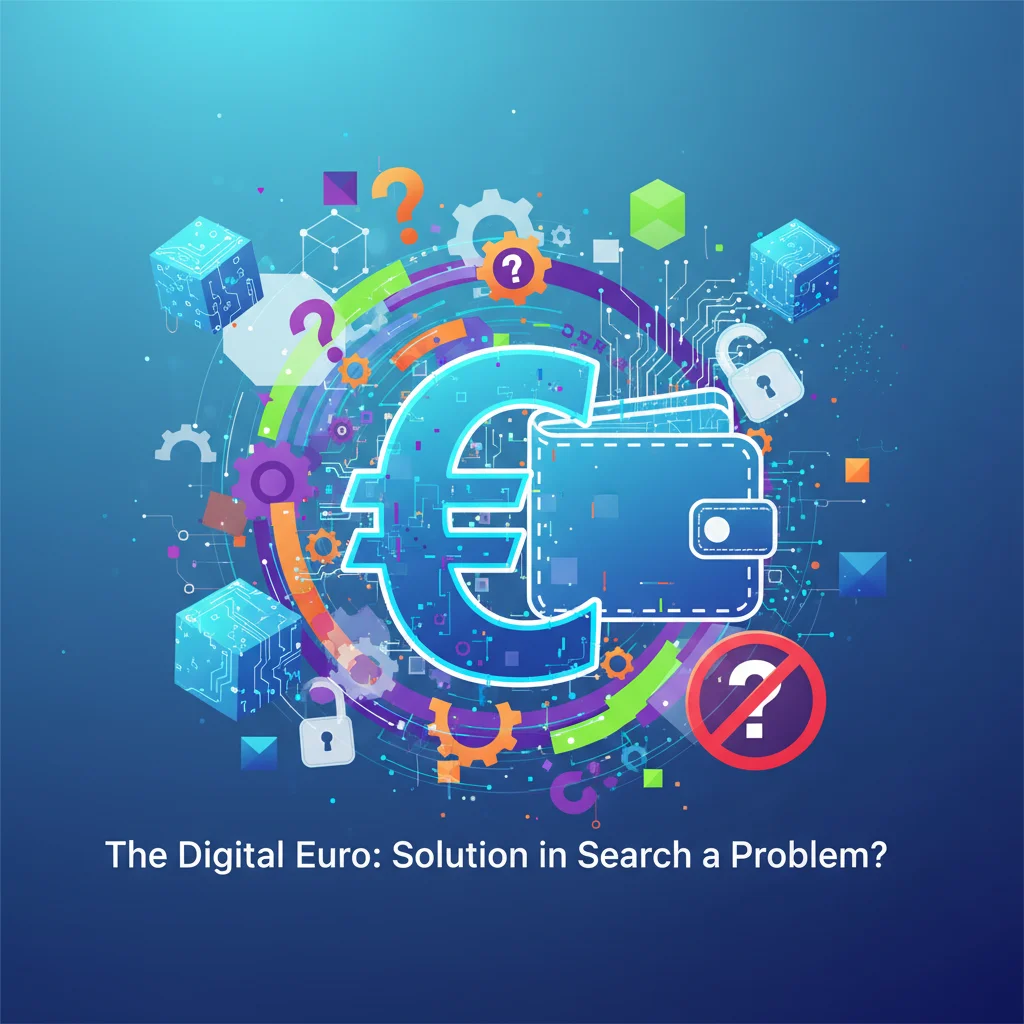
The Digital Euro: A Solution in Search of a Problem?
The world of finance is on the cusp of a monumental shift. Central banks globally are racing to develop their own digital currencies, and the European Central Bank (ECB) is no exception. Its flagship project, the digital euro, promises to revolutionize how we transact, invest, and interact with money. Yet, as the project moves from investigation to preparation, a crucial question echoes through the halls of finance and policy: Who is this for, and what problem does it actually solve?
This isn’t just idle speculation. In a pointed letter to the Financial Times, Apostolos Thomadakis, a researcher at the Centre for European Policy Studies, captured the growing sentiment of confusion. He argues that the official case presented to the public is “unconvincing” and fails to address the needs of the very consumers it’s meant to serve. The ECB’s justifications, he suggests, are abstract and technical, leaving citizens and businesses in the dark about the tangible benefits.
This blog post dives deep into the digital euro debate. We will dissect the ECB’s official rationale, explore the powerful unspoken motivations driving the project, and analyze the profound implications for the European economy, the banking sector, and the future of financial technology.
What is the Digital Euro, and Why Does the ECB Want One?
Before dissecting the controversy, let’s clarify what a digital euro is—and isn’t. A digital euro would be a Central Bank Digital Currency (CBDC). Think of it as a digital version of cash, issued and backed directly by the European Central Bank. Unlike the money in your commercial bank account (which is a liability of your bank), a digital euro would be a direct claim on the central bank, making it the safest form of digital money available.
It’s crucial to distinguish it from other forms of digital money:
- Cryptocurrencies (e.g., Bitcoin): These are decentralized, built on blockchain technology, and are not issued or backed by a central authority. Their value is highly volatile.
- Stablecoins (e.g., Tether, USDC): These are privately issued tokens that aim to maintain a stable value by pegging to a fiat currency like the US dollar. They carry issuer-specific risks.
- Commercial Bank Money: This is the digital money we use every day through debit cards, bank transfers, and apps. It’s created by commercial banks and represents a liability on their balance sheets.
The ECB officially states that a digital euro is needed to support the digitalization of the European economy and to foster strategic autonomy in payments. According to a report from the ECB, the primary objectives are to provide a risk-free digital payment option, ensure the Eurosystem maintains control over the monetary anchor, and resist the rise of foreign payment providers and private digital currencies that could undermine financial stability.
A Critical Look at the Official Justifications
While laudable, these official goals often feel disconnected from the daily realities of consumers and businesses. As Thomadakis pointed out, Europe already has a highly efficient, real-time payment system. So, what’s the compelling value proposition?
Let’s examine the key arguments:
- A Monetary Anchor in a Digital Age: The ECB argues that as cash usage declines, a digital euro is needed to ensure citizens always have access to public money. While theoretically sound, this is a preventative measure for a future problem, not a solution to a current one. For the average person, the distinction between central bank money and commercial bank money is academic—until there’s a crisis.
- Strategic Autonomy: This is perhaps the strongest official argument. Europe’s payment landscape is dominated by non-European players like Visa, Mastercard, Apple, and Google. A digital euro could create a homegrown infrastructure, reducing reliance on foreign firms and insulating the continent from geopolitical pressures. However, this is a top-down, geopolitical goal, not a bottom-up consumer benefit that makes someone choose it over their convenient Apple Pay.
- Financial Inclusion: Proponents suggest a digital euro could help those without access to traditional banking services. Yet, the unbanked population in the EU is relatively small, and it’s unclear how a digital currency would solve the underlying issues of poverty or lack of official documentation more effectively than existing initiatives.
The core issue is that these justifications lack a “killer app”—a clear, undeniable benefit that would make people switch from their current, highly convenient payment methods. This communication gap has led many to suspect that the true motivations lie elsewhere.
Beyond the Horizon: Why Coastal Economies Are the Next Frontier for Smart Investing
Comparing the Digital Euro to Existing Payment Methods
To understand the potential place of the digital euro in the financial ecosystem, it’s helpful to compare its proposed features against the tools we use today. The table below offers a simplified comparison.
| Feature | Cash | Debit/Credit Cards | Cryptocurrencies (e.g., Bitcoin) | Digital Euro (Proposed) |
|---|---|---|---|---|
| Issuer | Central Bank | Commercial Banks / Payment Networks | Decentralized Network | Central Bank |
| Privacy | High (Anonymous) | Low (Tracked by banks/networks) | Pseudonymous | TBD (Promised “cash-like” privacy for small payments) |
| Credit Risk | None | Bank Failure Risk (mitigated by deposit insurance) | High (Asset volatility) | None (Direct claim on ECB) |
| Offline Use | Yes | No | No | Yes (A key proposed feature) |
| Programmability | No | Limited | High (Smart Contracts) | Potentially High (Could enable automated payments) |
The Unspoken Agenda: What’s Really Driving the Project?
If the public case is weak, what are the powerful, behind-the-scenes drivers? This is where the implications for the broader economy and geopolitics become clear.
1. Geopolitical Counterweight: The global finance system is watching China’s digital yuan (e-CNY) with a mix of admiration and apprehension. Beijing is years ahead, and its CBDC could be used to increase the renminbi’s international role and challenge the dominance of the US dollar. As the Atlantic Council’s CBDC tracker shows, over 130 countries are exploring CBDCs, turning this into a new space race for monetary influence. A digital euro is Europe’s entry into this high-stakes game.
2. Reinforcing Monetary Policy: This is a controversial but critical point. A CBDC could give central banks powerful new tools. In a severe recession, a central bank could theoretically apply negative interest rates directly to citizens’ digital euro holdings to stimulate spending, something impossible with physical cash. It could also facilitate “helicopter money”—direct transfers to the public—with surgical precision. While the ECB has downplayed these possibilities, the technical capability would exist, fundamentally altering the toolkit of economics.
3. The War on Illicit Finance: Cash is anonymous, making it the preferred medium for the shadow economy, tax evasion, and illegal activities. A digital currency, even with privacy-preserving features, would be traceable by authorities under certain conditions. This offers governments a powerful tool to increase tax compliance and combat financial crime.
4. Data, Data, Data: In the 21st-century economy, data is the new oil. A CBDC would generate a massive amount of real-time, granular economic data. This would be an invaluable resource for policymakers to monitor economic health and react to crises. However, it also raises significant surveillance and privacy concerns that are far from resolved.
Beyond the Ticker: Redefining "British" for the New UK ISA
Implications for Banking, Fintech, and Investing
The introduction of a digital euro wouldn’t just be a new way to pay; it would send shockwaves through the entire financial industry.
The Banking Sector’s Dilemma: Commercial banks face a potential existential threat. Why keep your money in a commercial bank, which carries a small but real risk of failure, when you can hold it in a perfectly safe digital euro account with the ECB? This could lead to a flight of deposits from the banking system, especially during a crisis—a phenomenon known as digital bank disintermediation. To prevent this, the ECB has proposed holding limits (e.g., €3,000) on digital euro accounts, but the long-term competitive pressure on banks would be immense.
A Boom for Fintech and Innovation: On the other hand, a digital euro could be a launchpad for a new generation of financial technology. If designed with open APIs and programmability, it could enable everything from automated corporate payments and smart contracts to micropayments for the Internet of Things (IoT). This could create new markets and investing opportunities, allowing European fintech firms to build innovative services on top of a public infrastructure, much like the internet itself.
Impact on Markets and Trading: In the long run, a CBDC could revolutionize the plumbing of the stock market and other financial markets. The concept of “atomic settlement”—where the exchange of an asset and its payment happen simultaneously on a ledger—could eliminate counterparty risk and dramatically speed up trading and settlement cycles. This is a complex, long-term vision, but a digital euro is a foundational step.
The Ultimate Investment: Why Financial Literacy is the Bedrock of a Thriving Global Economy
Conclusion: A Project of Grand Ambition and Great Uncertainty
The digital euro is far more than a simple tech upgrade. It is a project of immense geopolitical and economic ambition, one that seeks to secure Europe’s monetary future in an increasingly digital and fragmented world. The official justifications, while not entirely without merit, mask a deeper and more compelling set of motivations, from countering China’s digital ambitions to potentially reshaping monetary policy for the 21st century.
However, as critics rightly point out, this grand vision has not been successfully translated into a compelling value proposition for the European public. The project is caught between competing goals: it must be as private as cash but as traceable as a bank transfer; as stable as public money but as innovative as a private fintech solution. Navigating these trade-offs will be the defining challenge.
For investors, business leaders, and citizens, the digital euro is a development to watch with keen interest and a healthy dose of skepticism. It represents a fundamental renegotiation of the relationship between the state, the bank, and the individual. Its success will ultimately hinge not on the elegance of its code, but on whether the ECB can finally answer the simple question: Why should anyone use it?


